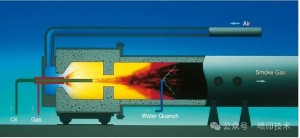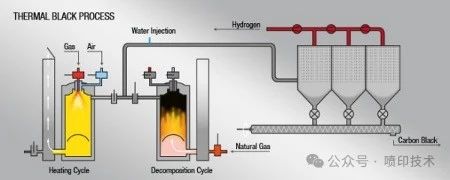The recent legislation proposed by the state of New York in the United States to ban the sale of carbon black within two years, including what carbon black is, why its use should be restricted, its use in the printing and other industries, how it is produced, its potential impact on the environment, and the feasibility of alternatives.
Over time, people have developed various methods for producing carbon black based on their technological level and geographical resource conditions. The furnace black process is currently the most efficient and widely used process, but we will also discuss other processes.
Furnace black process
This process uses hydrocarbons from oil and natural gas as raw materials to produce most of the world’s carbon black. The raw materials are injected into the reactor for thermal decomposition. However, they only partially burn in temperature and oxygen controlled environments. In this controlled reaction, carbon black particles are generated and collected. In today’s reactor systems, surface treatment can be applied when generating pigments to enhance the performance of specific applications (i.e. pigment dispersion and ink manufacturing).
Carbon black is a powder form of agglomerates, with primary particle sizes ranging from 10 to 80nm. For ease of processing, the powder can be compressed into particles. In addition to surface treatment modification, process conditions can also be modified to control characteristics such as structure and surface area.
catalytic pyrolysis
The thermal cracking carbon black process requires pumping natural gas into the preheating furnace under inert conditions. Then the gas decomposes into carbon black and hydrogen gas. Under anaerobic conditions, the generated carbon black will slowly form, and the resulting particles are usually very pure. Compared to furnace black, the particle size is larger and the structure is worse. This process uses a pair of furnaces. When one furnace is preheated, the other furnace decomposes natural gas into carbon black. The hydrogen gas generated during the decomposition process can be used to preheat the second furnace to produce the next batch of products in this discontinuous process.
Gas black process (Degussa process)
The gas black process was developed in Europe using coal tar fractions. The oil is heated until it evaporates. Pure evaporated oil is transported to the combustion chamber through hydrogen rich carrier gas. Due to the presence of oxygen, the resulting carbon black surface has a high degree of functionality composed of oxygen functional groups. This process can produce high-purity and small particle size carbon black. Like furnace black, the characteristics of gas black make it an ideal choice for inks and coatings.
Other historical processes for producing carbon black include lamp black, groove black, and acetylene black processes. If you want to produce some carbon black yourself, it’s very simple. Place a pot of cold water above the candle, but inside the orange flame. You will capture some of the burnt wax in the form of carbon black at the bottom of the pot. Basically, if you light candles, barbecue, burn incense, or use lemongrass candles to repel mosquitoes, you are making charcoal black.
Regulatory issues
When we talk about regulatory issues related to carbon black, the first step is to make a crucial distinction. Are we talking about dry powder carbon black as a pigment, or does it refer to carbon black present in dry ink films? Let’s first take a look at the powdered carbon black received by ink manufacturers.
Health risks
The biggest hidden danger of carbon black is that if not handled properly, dust explosions may occur. If the concentration of dust generated exceeds 50 grams per cubic meter, there is a risk of explosion or combustion in the presence of an ignition source. As long as management is done well and fire sources are carefully eliminated, this risk can be minimized.
The second issue is inhalation. The particles of carbon black pigment are very small, and if not covered, it is easy to diffuse. Short term inhalation of carbon black dust may cause irritation and upper respiratory discomfort. This may cause coughing and wheezing. But there is no evidence to suggest that acute contact can be life-threatening.
Long term inhalation of carbon black in animals can lead to lung overload and inflammation. Although inflammation may lead to genotoxic effects, carbon black itself is not considered mutagenic. In addition, these results are similar to other studies on insoluble inorganic particles in inhalation studies. Due to long-term exposure to carbon black and other insoluble particles leading to decreased lung capacity, it is always encouraged to wear personal protective equipment (PPE) and maintain good occupational health habits when using carbon black powder.
Carbon black does not irritate the eyes or skin. But it may cause mechanical irritation, and carbon black, like other powders, may dry the skin.
The International Agency for Research on Cancer (IARC) classifies carbon black powder as a Class 2B carcinogen. The International Carbon Black Association believes that the basis for this classification is that laboratory rats are particularly sensitive to inhaling high doses of low solubility particles. There is not enough evidence to prove the association between carbon black and human lung cancer. The non-profit American Conference of Government Industrial Hygienists (ACGIH) has concluded that carbon black is a confirmed animal carcinogen, but its association with humans is still unclear.
Once carbon black is formulated into ink or paint, all risks associated with its use as insoluble particles are eliminated. This is an important difference, and the Senate bill seems to overlook it, mistakenly referring to carbon black as a toxic substance. George Fuchs, Director of Regulatory Affairs and Technology at NAPIM, shared, “We are very concerned about this and have joined forces with multiple industry and business organizations to oppose this thoughtless and counterproductive legislation.”
environmental effect
It is estimated that during the production of over 15 million tons of carbon black, 29 to 79 million metric tons of carbon dioxide will be emitted. If hydrogen is used instead of natural gas, it is possible to reduce carbon footprint by 19%. Other potential environmental impacts include the release of monoxide
As we discussed, carbon black pigments are mainly made from petroleum fractions. Carbon black is produced from waste materials such as tires, and some companies are currently utilizing renewable resources to produce carbon black. Living Ink produces carbon black from biomass waste through a carbon negative process. They have improved the production process of screen printing ink, offset printing ink, and flexographic printing ink. In the near future, we are likely to see inkjet grade products. Like traditional carbon black, biomass derived carbon black pigments are produced by combustion in anaerobic environments. Unfortunately, these renewable forms of carbon black will also be prohibited by proposed state legislation.
If you want to consult our products, welcome to ask price, sent email to
us: lemsun002@126.com.
Post time: Jul-01-2024



